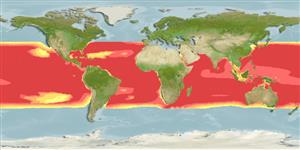>
Aulopiformes (Grinners) >
Omosudidae (Hammerjaws)
Etymology: Omosudis: Greek, omo = shoulder + Latin, sudis = esox, fish of the Rhine, cited by Plinius 9.15; it also means "stake" (Ref. 45335).
Eponymy: Rev. Richard Thomas Lowe (1802–1874) was a British botanist, ichthyologist and malacologist as well as being a clergyman. He graduated from Christ’s College, Cambridge (1825) and then took holy orders. He became a pastor in Madeira (1832), [...] (Ref. 128868), visit book page.
More on author: Günther.
Environment: milieu / climate zone / depth range / distribution range
Ecología
marino batipelágico; rango de profundidad 0 - 4000 m (Ref. 38732), usually 100 - 1000 m (Ref. 7344). Deep-water; 40°N - 40°S
Worldwide in tropical and temperate waters. South China Sea and East China Sea (Ref.74511)
Tamaño / Peso / Age
Maturity: Lm ? range ? - ? cm
Max length : 23.0 cm SL macho / no sexado; (Ref. 4475); common length : 20.0 cm NG macho / no sexado; (Ref. 5755)
Short description
Claves de identificación | Morfología | Morfometría
Espinas dorsales (total) : 0; Radios blandos dorsales (total) : 9 - 12; Espinas anales: 0; Radios blandos anales: 14 - 16. Brownish above, sides silvery, iridescent, with black peritoneum showing through (Ref. 7344).
Meso- and bathypelagic at 700-1830 m (Ref. 58302). Probably swift swimmers, which can avoid nets, captured singly or in small groups (Ref. 6692). Carnivorous, feed on squids and pelagic fishes (Ref. 6692). Oviparous and are synchronous hermaphrodites (Ref. 84733).
Life cycle and mating behavior
Madurez | Reproducción | Puesta | Huevos | Fecundidad | Larva
Are synchronous hermaphrodites, gonads consist of clearly defined and well separated ovarian and testicular regions with no indication of sequential maturation of the sex products (Ref. 84733). Also Ref. 103751.
Post, A., 1984. Omosudidae. p. 496-497. In P.J.P. Whitehead, M.-L. Bauchot, J.-C. Hureau, J. Nielsen and E. Tortonese (eds.) Fishes of the north-eastern Atlantic and the Mediterranean. UNESCO, Paris. Vol. 1. (Ref. 6692)
IUCN Red List Status (Ref. 130435: Version 2024-1)
Threat to humans
Harmless
Human uses
Pesquerías: sin interés
Herramientas
Special reports
Download XML
Fuentes de Internet
Estimates based on models
Preferred temperature (Ref.
123201): 4.8 - 21.3, mean 10.5 °C (based on 2379 cells).
Phylogenetic diversity index (Ref.
82804): PD
50 = 1.5000 [Uniqueness, from 0.5 = low to 2.0 = high].
Bayesian length-weight: a=0.00389 (0.00180 - 0.00842), b=3.12 (2.94 - 3.30), in cm total length, based on all LWR estimates for this body shape (Ref.
93245).
Nivel trófico (Ref.
69278): 4.3 ±0.64 se; based on food items.
Resiliencia (Ref.
120179): Medio, población duplicada en un tiempo mínimo de 1.4-4.4 años (Assuming tm=2-4).
Fishing Vulnerability (Ref.
59153): Low vulnerability (18 of 100).
